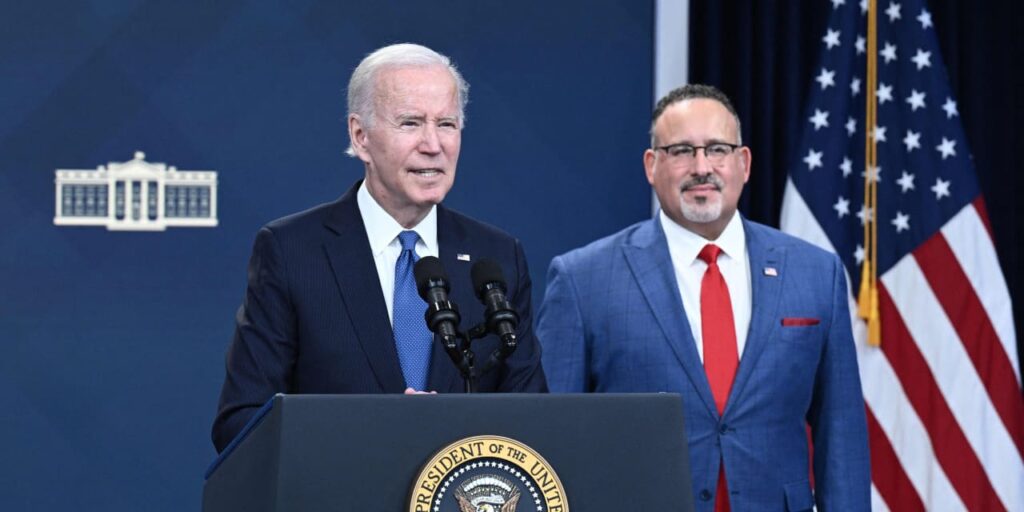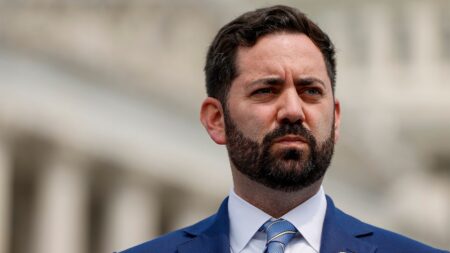More than 150,000 borrowers who have been in repayment on their student loans for at least 10 years will have their debt cancelled, the Biden administration announced Wednesday.
The 153,000 borrowers who will receive roughly $1.2 billion in debt relief are part of the first cohort of borrowers eligible for early debt forgiveness as part of the SAVE plan, an initiative the Biden administration launched last year.
Under that repayment plan, borrowers pay back their loans as a percentage of their income and have the remainder cancelled after a certain number of years. Borrowers using SAVE who took out $12,000 in studnet loans or less are eligible for debt relief after 10 years of payments. Originally that benefit wasn’t supposed to be available until July, but the Biden administration announced earlier this year that officials would start cancelling debt through that provision of the program this month.
The debt cancellation is part of the administration’s “unapologetic commitment to deliver as much relief as possible to as many borrowers as possible as quickly as possible,” Secretary of Education Miguel Cardona told reporters.
“The progress we’re announcing today demonstrates that we’re not only making good on that commitment but we’re doing so ahead of schedule.”
Announcement comes amid broader debt-relief efforts
Wednesday’s announcement comes amid other efforts from the Biden administration to push its student-loan agenda forward after the Supreme Court knocked down the White House’s initial plan to cancel up to $20,000 in student debt for a wide swath of borrowers last year. Student-debt forgiveness was a key plank of Biden’s 2020 campaign. But more than 40% of Gen Z swing-state voters said in a December poll that they didn’t think Biden was doing enough to mitigate student debt.
The president plans to speak about the debt relief in Los Angeles on Wednesday, and borrowers eligible for the relief will receive an email directly from Biden, officials said on a call with reporters. In the email, Biden will reiterate his administration’s efforts on student debt and encourage recipients to “share what this relief means to you.”
“I hope this relief gives you a little more breathing room,” the email reads. “I’ve heard from countless people who have told me that relieving the burden of their student-loan debt will allow them to support themselves and their families, buy their first home, start a small business and move forward with life plans they’ve put on hold.”
The Department of Education will also be reaching out to borrowers who could be eligible for early student-loan forgiveness if they enroll in SAVE, administration officials told reporters.
Though the Biden administration has touted SAVE as transformative for borrowers and encouraged them to sign up, the government and student-loan servicers struggled to implement the plan in its early weeks. In the months leading up to and following the return to repayment after a more-than-three-year pause, borrowers reported challenges enrolling in SAVE.
At the end of October, more than 450,000 applications for income-driven repayment plans, including SAVE, were still pending with a borrower’s servicer for more than 30 days, the Consumer Financial Protection Bureau reported in January.
SAVE offers more generous benefits than previous repayment plans
Borrowers have been able to pay their student loans as a percentage of their income for years. But SAVE offers a few key benefits that aren’t available under previous versions of income-driven repayment. For example, if a borrower’s payment isn’t enough to cover the interest, then the government covers the rest. That means borrowers using SAVE don’t see their balances grow, a perennial source of stress for borrowers using other forms of income-driven repayment.
In addition, the earliest borrowers can have their debt cancelled under most income-driven repayment plans is after 20 years of payments. By contrast, SAVE allows borrowers who borrowed relatively little to attend college — $12,000 or less — to have the debt wiped away after just 10 years of payments. In addition, for every $1,000 above $12,000 in original balance, borrowers are eligible for forgiveness after an additional year of payments (so $13,000 in debt requires 11 years of payments, $14,000 in debt requires 12 years of payments etc.)
By providing relief earlier for borrowers who took on relatively small debt loads, officials are targeting the forgiveness towards community college students and borrowers who struggle the most to repay their student debt.
The debt relief announced Wednesday is distinct from the Biden administration’s mass student-loan forgiveness plan, which would likely impact borrowers with all levels of student debt. In the wake of the Supreme Court’s decision last year, Biden vowed to take another stab at broad student-loan relief. Officials are in the midst of that process.
As part of those efforts, the Department of Education said last week that it would like to make borrowers experiencing financial hardship as a result of their student loans eligible to have their debt cancelled as part of the broader relief effort. Stakeholders will meet this week to discuss the proposal as part of a process that will help to determine the scope of a new student debt-forgiveness initiative.
The outcome of the process likely won’t be known for months. The final debt-forgiveness plan is likely to face legal challenges.
In the meantime, the Biden administration has been cancelling debt for borrowers who have technically had the right to student-loan forgiveness under the law for years, but who hadn’t been able to access it due to technicalities. So far, officials have approved nearly $138 billion in debt cancellation for almost 3.9 million borrowers. That includes some public servants, some borrowers who have been in repayment on their debt for at least 20 years and borrowers who have been scammed by their schools.
A senior administration official told reporters that he didn’t have an update on how many of the 3.9 million borrowers have already seen their loan balances disappear.
Read the full article here












